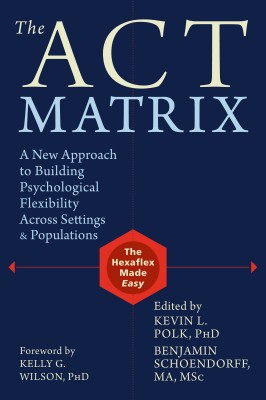 The ACT Matrix: A New Approach to Building Psychological Flexibility Across Settings and Populations is a refreshing user-friendly book that transforms a somewhat esoteric theoretical framework (Acceptance and Commitment Therapy, or ACT) directly into an accessible therapeutic tool for counselors. Kevin Polk and Benjamin Schoendorff present a very practical edited text that features contributions from authors who share their direct experiences with using an accessible version of ACT in their work with a variety of clients and presenting concerns.
The ACT Matrix: A New Approach to Building Psychological Flexibility Across Settings and Populations is a refreshing user-friendly book that transforms a somewhat esoteric theoretical framework (Acceptance and Commitment Therapy, or ACT) directly into an accessible therapeutic tool for counselors. Kevin Polk and Benjamin Schoendorff present a very practical edited text that features contributions from authors who share their direct experiences with using an accessible version of ACT in their work with a variety of clients and presenting concerns.
The book begins with a history of the matrix, which in essence is a versatile version of ACT. ACT is a philosophical and theoretical framework that, simply put, is designed to help clients live with (rather than eradicate) troubling psychological symptoms, while at the same time acting in a way that brings meaning and purpose to their lives. While ACT is an evidenced-based practice that has shown great utility across a variety of therapeutic arenas, its main tenets can prove challenging for those who (a) have been trained to help clients eliminate maladaptive symptomology and/or (b) prefer a structured set of helping skills that follow a predictable pattern. For these reasons, I sometimes caution graduate counseling students against using ACT too soon in their professional careers, prompting them to revisit ACT when they (a) are no longer encumbered by their own internal perfectionistic conflicts and (b) are ready for a system of helping that meets clients in the midst of their pain, and helps them to accept their current circumstances rather than trying to avoid them. At least, these were my standard set of cautions; but now I can recommend the matrix.
To quote the book itself, “The matrix is an interactive diagram for increasing psychological flexibility in almost any context at any time” (Polk & Schoendorff, 2014, p. 1). After discussing the origins of the matrix and the underlying principles of ACT, the editors turn to experts in a variety of clinical arenas who have successfully adapted the matrix in their work with clients. These clinicians share their expertise in using the matrix with presenting issues such as addictions, chronic pain, eating disorders, chronic and severe disorders (e.g., depression, anxiety, self-destructive behaviors), and post-traumatic stress disorder (PTSD). In addition to the examples of these presenting concerns, the book offers practical implications for using the matrix in such setting as couples counseling, psychiatric practice and case consultation. The authors even dedicate chapters to using the matrix with the general public, in the school systems and in the business world. Using a variety of clinical case studies, easy-to-follow (and replicate) graphics, and step-by-step instructions, the authors lead the reader in very practical exercises that can be used directly with struggling clients.
The ACT Matrix would be appropriate to use with graduate students in a variety of courses, including those that are fairly general (e.g., diagnosis and treatment, advanced counseling skills, clinical experience courses such as practicum and internship) as well as those that are more clinically specific (e.g., addiction counseling, couples counseling, crisis/trauma counseling). For practicing clinicians looking to build their professional competence in order to work with clients who appear to be stuck in the experience of their symptoms, The ACT Matrix offers numerous exercises that will prove to be quite effective.
Reviewed by: W. Bryce Hagedorn, NCC, MAC, University of Central Florida, Orlando, FL.
Polk, K. L., & Schoendorff, B. (Eds.). (2014). The ACT Matrix: A new approach to building psychological flexibility across settings and populations. Oakland, CA: New Harbinger.
The Professional Counselor
https://tpcwordpress.azurewebsites.net
